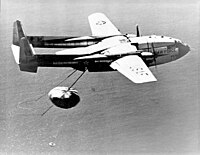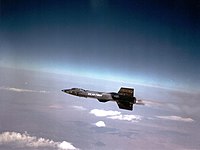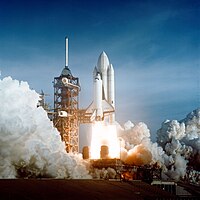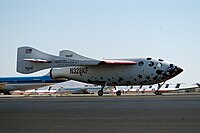Spaceflight

| Part ofa serieson |
| Spaceflight |
|---|
 |
|
|
Spaceflight(orspace flight) is an application ofastronauticsto fly objects, usuallyspacecraft,into or throughouter space,eitherwithorwithout humans on board.Most spaceflight is uncrewed and conducted mainly with spacecraft such assatellitesinorbit around Earth,but also includesspace probesfor flights beyond Earth orbit. Such spaceflight operate either byteleroboticorautonomouscontrol. The more complex human spaceflight has been pursued soon after the first orbital satellites and has reached theMoonand permanenthuman presence in spacearound Earth, particularly with the use ofspace stations.Human spaceflight programsinclude theSoyuz,Shenzhou,the pastApollo Moon landingand theSpace Shuttle programs.Other current spaceflight are conducted to theInternational Space Stationand to China'sTiangong Space Station.
Spaceflight is used for placing in Earth's orbitcommunications satellites,reconnaissance satellites,Earth observation satellites,but also forspace explorationsuch asspace observatoriesand space probes, or even forspace tourism.
Spaceflight can be achieved with different types oflaunch systems,conventionally byrocket launching,which provide the initial thrust to overcome the force of gravity and propel a spacecraft from the surface of the Earth. Once in space, the motion of a spacecraft—both when unpropelled and when under propulsion—is covered by the area of study calledastrodynamics.
Some spacecraft remain in space practically indefinitely, which has created the problem of space pollution in the form oflight pollutionandspace junk,which is a hazard to spaceflight. Otherwise spacecraft are terminated byatmospheric reentry,in which they disintegrate, or if they do not, their reentry is mostly controlled to safely reach a surface by landing or impacting, often being dumped into the oceanicspacecraft cemetery.Spacecraft have thus been the subject of somespace traffic management.
Terminology[edit]
There are several terms that refer to a flight into or throughouter space.
Aspace missionrefers to a spaceflight intended to achieve an objective. Objectives for space missions may includespace exploration,space research,and national firsts in spaceflight.
Space transportis the use of spacecraft to transport people or cargo into or through outer space. This may includehuman spaceflightandcargo spacecraftflight.
History[edit]
The first theoretical proposal of space travel usingrocketswas published by Scottish astronomer and mathematicianWilliam Leitch,in an 1861 essay "A Journey Through Space".[1]More well-known (though not widely outside Russia) isKonstantin Tsiolkovsky's work, "Исследование мировых пространств реактивными приборами"(The Exploration of Cosmic Space by Means of Reaction Devices), published in 1903.
Spaceflight became an engineering possibility with the work ofRobert H. Goddard's publication in 1919 of his paperA Method of Reaching Extreme Altitudes.His application of thede Laval nozzletoliquid-fuel rocketsimproved efficiency enough for interplanetary travel to become possible. He also proved in the laboratory that rockets would work in the vacuum of space;[specify]nonetheless, his work was not taken seriously by the public. His attempt to secure an Army contract for a rocket-propelled weapon in thefirst World Warwas defeated by theNovember 11, 1918 armistice with Germany.Working with private financial support, he was the first to launch a liquid-fueled rocket in 1926. Goddard's papers were highly influential internationally in his field.
In the course ofWorld War IIthe first guided rockets, theV-2were developed and employed as weapons byNazi Germany.At a test flight in June 1944 one such rocket reached space at an altitude of 189 kilometers (102 nautical miles), becoming the first object in human history to do so.[2]At the end of World War II, most of the V-2 rocket team including its headWernher von Braunsurrendered to the United States, and were expatriated to work on American missiles at what became theArmy Ballistic Missile Agency,producing missiles such asJuno IandAtlas.
At that time theSoviet UnionunderJoseph Stalinwas developingintercontinental ballistic missilesto carrynuclear weaponsas a counter measure to United States bomber planes. The Tsiolkovsky influencedSergey Korolevbecame the chief rocket designer, derivatives of hisR-7 Semyorkamissiles were used to launch the world's first artificial Earthsatellite,Sputnik 1,on October 4, 1957, and later the first human to orbit the Earth,Yuri GagarininVostok 1,on April 12, 1961.[3]
The first US satellite wasExplorer 1,launched on February 1, 1958, and the first American in orbit becameJohn GlenninFriendship 7on February 20, 1962. As director of theMarshall Space Flight Center,Von Braun oversaw development of a larger class of rocket calledSaturn,which allowed the US to send the first two humans,Neil ArmstrongandBuzz Aldrin,to the Moon and back onApollo 11in July 1969. At the same time, the Soviet Union secretly tried but failed to develop theN1 rocket,meant to give them the capability to land humans on the Moon.
Ever since spaceflight has been widely employed for placing satellites into orbit around Earth for a broad range of purposes, for sending uncrewed spacecraft exploring space beyond the Moon and having continuous crewedhuman presence in spacewith a series ofspace stations,from theSalyutprogramto theInternational Space Station.
Phases[edit]
Launch[edit]
Rockets are the only means currently capable of reaching orbit or beyond. Othernon-rocket spacelaunchtechnologies have yet to be built, or remain short of orbital speeds. Arocket launchfor a spaceflight usually starts from aspaceport(cosmodrome), which may be equipped with launch complexes andlaunch padsfor vertical rocket launches and runways for takeoff and landing of carrier airplanes and winged spacecraft. Spaceports are situated well away from human habitation for noise and safety reasons.ICBMshave various special launching facilities.
A launch is often restricted to certainlaunch windows.These windows depend upon the position of celestial bodies and orbits relative to the launch site. The biggest influence is often the rotation of the Earth itself. Once launched, orbits are normally located within relatively constant flat planes at a fixed angle to the axis of the Earth, and the Earth rotates within this orbit.
Alaunch padis a fixed structure designed to dispatch airborne vehicles. It generally consists of a launch tower and flame trench. It is surrounded by equipment used to erect, fuel, and maintain launch vehicles. Before launch, the rocket can weigh many hundreds of tonnes. TheSpace ShuttleColumbia,onSTS-1,weighed 2,030 tonnes (4,480,000 lb) at takeoff.
Reaching space[edit]
The most commonly used definition ofouter spaceis everything beyond theKármán line,which is 100 kilometers (62 mi) above the Earth's surface. The United States sometimes defines outer space as everything beyond 50 miles (80 km) in altitude.
Rocketengines are the only currently practical means of reaching space. Conventional airplane engines cannot reach space due to the lack of oxygen. Rocket engines expelpropellantto provide forwardthrustthat generates enoughdelta-v(change in velocity) to reach orbit.
For crewed launch systemslaunch escape systemsare frequently fitted to allow astronauts to escape in the case of emergency.
Alternatives[edit]
Many ways to reach space other than rocket engines have been proposed. Ideas such as thespace elevator,andmomentum exchange tetherslikerotovatorsorskyhooksrequire new materials much stronger than any currently known. Electromagnetic launchers such aslaunch loopsmight be feasible with current technology. Other ideas include rocket-assisted aircraft/spaceplanes such asReaction Engines Skylon(currently in early stage development),scramjetpowered spaceplanes, andRBCCpowered spaceplanes. Gun launch has been proposed for cargo.
Leaving orbit[edit]
This sectionpossibly containsoriginal research.(June 2018) |
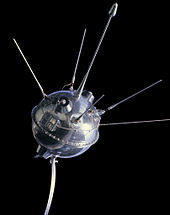
Achieving a closed orbit is not essential to lunar and interplanetary voyages. Early Soviet space vehicles successfully achieved very high altitudes without going into orbit.NASAconsidered launchingApollomissions directly into lunar trajectories but adopted the strategy of first entering a temporaryparking orbitand then performing a separate burn several orbits later onto a lunar trajectory.[5]
The parking orbit approach greatly simplified Apollo mission planning in several important ways. It acted as a "time buffer" and substantially widened the allowablelaunch windows.The parking orbit gave the crew and controllers several hours to thoroughly check out the spacecraft after the stresses of launch before committing it for a long journey to the Moon.[5]
Apollo missions minimized the performance penalty of the parking orbit by keeping its altitude as low as possible. For example,Apollo 15used an unusually low parking orbit of 92.5 nmi × 91.5 nmi (171.3 km × 169.5 km) which is not sustainable for very long due to friction with theEarth's atmosphere,but the crew would only spend three hours before reigniting theS-IVBthird stage to put them on a lunar-bound trajectory.[6]
Robotic missions do not require an abort capability or radiation minimization, and because modern launchers routinely meet "instantaneous" launch windows, space probes to the Moon and other planets generally use direct injection to maximize performance. Although some might coast briefly during the launch sequence, they do not complete one or more full parking orbits before the burn that injects them onto an Earth escape trajectory.
The escape velocity from a celestial body decreases with altitude above that body. However, it is more fuel-efficient for a craft to burn its fuel as close to the ground as possible; seeOberth effectand reference.[7]This is another way to explain the performance penalty associated with establishing the safe perigee of a parking orbit.
Astrodynamics[edit]
Astrodynamics is the study of spacecraft trajectories, particularly as they relate to gravitational and propulsion effects. Astrodynamics allows for a spacecraft to arrive at its destination at the correct time without excessive propellant use. Anorbital maneuvering systemmay be needed to maintain or change orbits.
Non-rocket orbital propulsion methods includesolar sails,magnetic sails,plasma-bubble magnetic systems,and usinggravitational slingshoteffects.
Transfer energy[edit]
The term "transfer energy" means the total amount ofenergyimparted by a rocket stage to its payload. This can be the energy imparted by afirst stageof alaunch vehicleto an upper stage plus payload, or by an upper stage or spacecraftkick motorto aspacecraft.[8][9]
Reaching space station[edit]
In order to reach towards aspace station,a spacecraft would have to arrive at the sameorbitand approach to a very close distance (e.g. within visual contact). This is done by a set of orbital maneuvers calledspace rendezvous.
After rendezvousing with the space station, the space vehicle then docks or berths with the station. Docking refers to joining of two separate free-flying space vehicles,[10][11][12][13]while berthing refers to mating operations where an inactive vehicle is placed into the mating interface of another space vehicle by using arobotic arm.[10][12][13]
Reentry[edit]
Vehicles in orbit have large amounts of kinetic energy. This energy must be discarded if the vehicle is to land safely without vaporizing in the atmosphere. Typically this process requires special methods to protect againstaerodynamic heating.The theory behind reentry was developed byHarry Julian Allen.Based on this theory, reentry vehicles present blunt shapes to the atmosphere for reentry. Blunt shapes mean that less than 1% of the kinetic energy ends up as heat reaching the vehicle, and the remainder heats up the atmosphere.
Landing and recovery[edit]
TheMercury,Gemini,andApollocapsules allsplashed downin the sea. These capsules were designed to land at relatively low speeds with the help of a parachute. Soviet/Russian capsules forSoyuzmake use of a big parachute and braking rockets to touch down on land.Spaceplaneslike theSpace Shuttleland like aglider.
After a successful landing the spacecraft, its occupants, and cargo can be recovered. In some cases, recovery has occurred before landing: while a spacecraft is still descending on its parachute, it can be snagged by a specially designed aircraft. Thismid-air retrievaltechnique was used to recover the film canisters from theCoronaspy satellites.
Types[edit]
Uncrewed[edit]


Uncrewed spacecraftor robotic spacecraft arespacecraftwithoutpeopleon board. Uncrewed spacecraft may have varying levels of autonomy from human input, such asremote control,or remote guidance. They may also beautonomous,in which they have a pre-programmed list of operations that will be executed unless otherwise instructed. A robotic spacecraft for scientific measurements is often called a space probe orspace observatory.
Many space missions are more suited toteleroboticrather thancrewedoperation, due to lower cost and risk factors. In addition, some planetary destinations such asVenusor the vicinity ofJupiterare too hostile for human survival, given current technology. Outer planets such asSaturn,Uranus,andNeptuneare too distant to reach with current crewed spaceflight technology, so telerobotic probes are the only way to explore them. Telerobotics also allows exploration of regions that are vulnerable to contamination by Earth micro-organisms since spacecraft can be sterilized. Humans can not be sterilized in the same way as a spaceship, as they coexist with numerous micro-organisms, and these micro-organisms are also hard to contain within a spaceship or spacesuit.
The first uncrewed space mission wasSputnik,launched October 4, 1957 to orbit the Earth. Nearly allsatellites,landersandroversare robotic spacecraft. Not every uncrewed spacecraft is a robotic spacecraft; for example, a reflector ball is a non-robotic uncrewed spacecraft. Space missions where otheranimalsbut no humans are on-board are called uncrewed missions.
Many habitable spacecraft also have varying levels of robotic features. For example, the space stationsSalyut 7andMir,and theInternational Space StationmoduleZarya,were capable of remote guided station-keeping and docking maneuvers with both resupply craft and new modules.Uncrewed resupply spacecraftare increasingly used for crewedspace stations.Human[edit]

The first human spaceflight wasVostok 1on April 12, 1961, on whichcosmonautYuri Gagarinof theUSSRmade one orbit around the Earth. In official Soviet documents, there is no mention of the fact that Gagarin parachuted the final seven miles.[14]As of 2020, the only spacecraft regularly used for human spaceflight areSoyuz,Shenzhou,andCrew Dragon.The U.S.Space Shuttlefleet operated from April 1981 until July 2011.SpaceShipOnehas conducted two human suborbital spaceflights.
Sub-orbital[edit]
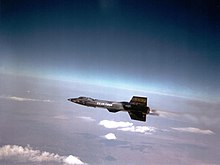
On asub-orbital spaceflightthe spacecraft reaches space and then returns to the atmosphere after following a (primarily) ballistic trajectory. This is usually because of insufficientspecific orbital energy,in which case a suborbital flight will last only a few minutes, but it is also possible for an object with enough energy for an orbit to have a trajectory that intersects the Earth's atmosphere, sometimes after many hours.Pioneer 1was NASA's firstspace probeintended to reach the Moon. A partial failure caused it to instead follow a suborbital trajectory to an altitude of 113,854 kilometers (70,746 mi) before reentering the Earth's atmosphere 43 hours after launch.
The most generally recognized boundary of space is theKármán line100 km (62 mi) above sea level. (NASA alternatively defines an astronaut as someone who has flown more than 80 km (50 mi) above sea level.) It is not generally recognized by the public that the increase in potential energy required to pass the Kármán line is only about 3% of the orbital energy (potential plus kinetic energy) required by the lowest possible Earth orbit (a circular orbit just above the Kármán line.) In other words, it is far easier to reach space than to stay there. On May 17, 2004,Civilian Space eXploration Teamlaunched the GoFast rocket on a suborbital flight, the first amateur spaceflight. On June 21, 2004,SpaceShipOnewas used for the firstprivately fundedhuman spaceflight.
Point-to-point[edit]
Point-to-point, or Earth to Earth transportation, is a category ofsub-orbital spaceflightin which a spacecraft provides rapid transport between two terrestrial locations.[15]A conventional airline route betweenLondonandSydney,a flight that normally lastsover twenty hours,could be traversed in less than one hour.[16]While no company offers this type of transportation today,SpaceXhas revealed plans to do so as early as the 2020s usingStarship.Suborbital spaceflight over an intercontinental distance requires a vehicle velocity that is only a little lower than the velocity required to reach low Earth orbit.[17]If rockets are used, the size of the rocket relative to the payload is similar to an Intercontinental Ballistic Missile (ICBM). Any intercontinental spaceflight has to surmount problems of heating during atmosphere re-entry that are nearly as large as those faced by orbital spaceflight.
Orbital[edit]

A minimalorbital spaceflightrequires much higher velocities than a minimal sub-orbital flight, and so it is technologically much more challenging to achieve. To achieve orbital spaceflight, the tangential velocity around the Earth is as important as altitude. In order to perform a stable and lasting flight in space, the spacecraft must reach the minimalorbital speedrequired for aclosed orbit.
Interplanetary[edit]
Interplanetary spaceflightis flight between planets within a singleplanetary system.In practice, the use of the term is confined to travel between the planets of ourSolar System.Plans for future crewed interplanetary spaceflight missions often include final vehicle assembly in Earth orbit, such as NASA'sConstellation programand Russia'sKliper/Paromtandem.
Interstellar[edit]
New Horizonsis the fifth spacecraft put on an escape trajectory leaving theSolar System.Voyager 1,Voyager 2,Pioneer 10,Pioneer 11are the earlier ones. The one farthest from the Sun isVoyager 1,which is more than 100AUdistant and is moving at 3.6 AU per year.[18]In comparison,Proxima Centauri,the closest star other than the Sun, is 267,000 AU distant. It will takeVoyager 1over 74,000 years to reach this distance. Vehicle designs using other techniques, such asnuclear pulse propulsionare likely to be able to reach the nearest star significantly faster. Another possibility that could allow for human interstellar spaceflight is to make use oftime dilation,as this would make it possible for passengers in a fast-moving vehicle to travel further into the future while aging very little, in that their great speed slows down the rate of passage of on-board time. However, attaining such high speeds would still require the use of some new, advanced method ofpropulsion.Dynamic soaringas a way to travel across interstellar space has been proposed as well.[19][20]
Intergalactic[edit]
Intergalactic travel involves spaceflight between galaxies, and is considered much more technologically demanding than even interstellar travel and, by current engineering terms, is consideredscience fiction.However, theoretically speaking, there is nothing to conclusively indicate that intergalactic travel is impossible. To date several academics have studied intergalactic travel in a serious manner.[21][22][23]
Spacecraft[edit]
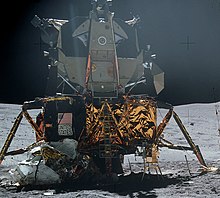
Spacecraft are vehicles designed to operate in space.
The first 'true spacecraft' is sometimes said to beApollo Lunar Module,[24]since this was the only crewed vehicle to have been designed for, and operated only in space; and is notable for its non-aerodynamic shape.
Propulsion[edit]
Spacecraft today predominantly userocketsforpropulsion,but other propulsion techniques such asion drivesare becoming more common, particularly for uncrewed vehicles, and this can significantly reduce the vehicle's mass and increase itsdelta-v.
Launch systems[edit]
Launch systems are used to carry a payload from Earth's surface into outer space.
Expendable[edit]
Most current spaceflight usesmulti-stageexpendable launch systems to reach space.
Reusable[edit]
The first reusable spacecraft, theX-15,was air-launched on a suborbital trajectory on 19 July 1963. The first partially reusable orbital spacecraft, theSpace Shuttle,was launched by the USA on the 20th anniversary ofYuri Gagarin's flight, on 12 April 1981. During the Shuttle era, six orbiters were built, all of which flown in the atmosphere and five of which flown in space. TheEnterprisewas used only for approach and landing tests, launching from the back of aBoeing 747and gliding to deadstick landings atEdwards AFB, California.The first Space Shuttle to fly into space was theColumbia,followed by theChallenger,Discovery,Atlantis,andEndeavour.TheEndeavourwas built to replace theChallenger,which waslostin January 1986. TheColumbiabroke upduring reentry in February 2003.
The first automatic partially reusable spacecraft was theBuran(Snowstorm), launched by the USSR on 15 November 1988, although it made only one flight. Thisspaceplanewas designed for a crew and strongly resembled the US Space Shuttle, although its drop-off boosters used liquid propellants and its main engines were located at the base of what would be the external tank in the American Shuttle. Lack of funding, complicated by the dissolution of the USSR, prevented any further flights of Buran.
The Space Shuttle was retired in 2011 due mainly to its old age. The Shuttle's human transport role is to be replaced by theSpaceX Dragon 2andCST-100in the 2020s. The Shuttle's heavy cargo transport role is now done by commercial launch vehicles.
Scaled CompositesSpaceShipOnewas a reusablesuborbital spaceplanethat carried pilotsMike MelvillandBrian Binnieon consecutive flights in 2004 to win theAnsari X Prize.The Spaceship Companyhas built its successorSpaceShipTwo.A fleet of SpaceShipTwos operated byVirgin Galacticplanned to begin reusableprivate spaceflightcarrying paying passengers (space tourists) in 2008, but this was delayed due to an accident in the propulsion development.[25]
SpaceXachieved the first vertical soft landing of a re-usable orbital rocket stage on December 21, 2015, after delivering 11Orbcomm OG-2commercial satellites intolow Earth orbit.[26]
The first Falcon 9 second flight occurred on 30 March 2017.[27]SpaceX now routinely recovers and reusestheir first stages, with the intent of reusing fairings as well.[28]SpaceX is now developing a fully reusable super heavy lift rocket known asStarship,hoped to drastically reduce the price of space exploration due to being fully reusable.
Challenges[edit]
Safety[edit]
All launch vehicles contain a huge amount of energy that is needed for some part of it to reach orbit. There is therefore some risk that this energy can be released prematurely and suddenly, with significant effects. When aDelta IIrocket exploded 13 seconds after launch on January 17, 1997, there were reports of store windows 10 miles (16 km) away being broken by the blast.[29]
Space is a fairly predictable environment, but there are still risks of accidental depressurization and the potential failure of equipment, some of which may be very newly developed.
In April 2004 theInternational Association for the Advancement of Space Safetywas established in theNetherlandsto further international cooperation and scientific advancement in space systems safety.[30]
Weightlessness[edit]

In a microgravity environment such as that provided by a spacecraft in orbit around the Earth, humans experience a sense of "weightlessness." Short-term exposure to microgravity causesspace adaptation syndrome,a self-limiting nausea caused by derangement of thevestibular system.Long-term exposure causes multiple health issues. The most significant is bone loss, some of which is permanent, but microgravity also leads to significantdeconditioningof muscular and cardiovascular tissues.
Radiation[edit]
Once above the atmosphere, radiation due to theVan Allen belts,solar radiationandcosmic radiationissues occur and increase. Further away from the Earth,solar flarescan give a fatal radiation dose in minutes, and thehealth threat from cosmic radiationsignificantly increases the chances of cancer over a decade exposure or more.[31]
Life support[edit]
In human spaceflight, thelife support systemis a group of devices that allow a human being to survive in outer space.NASAoften uses the phrase Environmental Control and Life Support System or the acronym ECLSS when describing these systems for itshuman spaceflightmissions.[32]The life support system may supply:air,waterandfood.It must also maintain the correct body temperature, an acceptable pressure on the body and deal with the body's waste products. Shielding against harmful external influences such as radiation and micro-meteorites may also be necessary. Components of the life support system arelife-critical,and are designed and constructed usingsafety engineeringtechniques.
Space weather[edit]

Space weather is the concept of changing environmental conditions inouter space.It is distinct from the concept ofweatherwithin aplanetary atmosphere,and deals with phenomena involving ambientplasma,magnetic fields,radiationand othermatterin space (generally close to Earth but also ininterplanetary,and occasionallyinterstellar medium). "Space weather describes the conditions in space that affect Earth and its technological systems. Our space weather is a consequence of the behavior of the Sun, the nature of Earth's magnetic field, and our location in the Solar System."[33]
Space weather exerts a profound influence in several areas related to space exploration and development. Changing geomagnetic conditions can induce changes in atmospheric density causing the rapid degradation of spacecraft altitude inLow Earth orbit.Geomagnetic storms due to increased solar activity can potentially blind sensors onboard spacecraft, or interfere with on-board electronics. An understanding of space environmental conditions is also important in designing shielding and life support systems for crewed spacecraft.
Environmental considerations[edit]
Exhaust pollution of rockets depends on the produced exhausts by the propellants reactions and the location of exhaustion. They mostly exhaustgreenhouse gasesand sometimes toxic components. Particularly at higher levels of the atmosphere the potency of exhausted gases as greenhouse gases increases considerably
.[34]Many solid rockets have chlorine in the form ofperchlorateor other chemicals, and this can cause temporary local holes in the ozone layer. Re-entering spacecraft generate nitrates which also can temporarily impact the ozone layer. Most rockets are made of metals that can have an environmental impact during their construction. While spaceflight altogether pollutes at a fraction of other human activities, it still does pollute heavily if calculated per passenger.[34]
In addition to the atmospheric effects there are effects on the near-Earth space environment. There is the possibility that orbit could become inaccessible for generations due to exponentially increasingspace debriscaused byspallingof satellites and vehicles (Kessler syndrome). Many launched vehicles today are therefore designed to be re-entered after use.
Regulation[edit]
A wide range of issues such asspace traffic managementorliabilityhave been issues of spaceflight regulation.
Participation and representation of all humanity in spaceflight is an issue of internationalspace lawever since the first phase of space exploration.[35]Even though some rights of non-spacefaring countries have been secured, sharing of space for all humanity is still criticized asimperialistand lacking, understanding spaceflight as a resource.[35]
Applications[edit]

Current and proposed applications for spaceflight include:
- Earth observation satellitessuch asspy satellites,weather satellites
- Space exploration
- Communication satellites
- Satellite television
- Satellite navigation
- Space tourism
- Protecting Earth frompotentially hazardous objects
- Space colonization
Most early spaceflight development was paid for by governments. However, today major launch markets such as communication satellites and satellite television are purely commercial, though many of the launchers were originally funded by governments.
Private spaceflightis a rapidly developing area: space flight that is not only paid for by corporations or even private individuals, but often provided byprivate spaceflight companies.These companies often assert that much of the previous high cost of access to space was caused by governmental inefficiencies they can avoid. This assertion can be supported by much lower published launch costs for private space launch vehicles such asFalcon 9developed with private financing. Lower launch costs and excellent safety will be required for the applications such as space tourism and especially space colonization to become feasible for expansion.
Spacefaring[edit]

To bespacefaringis to be capable of and active in the operation ofspacecraft.It involves a knowledge of a variety of topics and development of specialised skills including:aeronautics;astronautics;programs to trainastronauts;space weatherand forecasting; spacecraft operations; operation of various equipment; spacecraft design and construction; atmospheric takeoff and reentry;orbital mechanics(a.k.a. astrodynamics); communications; engines and rockets; execution of evolutions such as towing,microgravityconstruction, andspace docking;cargo handling equipment, dangerous cargos and cargo storage;spacewalking;dealing with emergencies;survival at spaceand first aid; fire fighting;life support.The degree of knowledge needed within these areas is dependent upon the nature of the work and the type of vessel employed. "Spacefaring" is analogous toseafaring.
There has never been a crewed mission outside theEarth–Moonsystem. However, the United States, Russia, China,European Space Agency(ESA) countries, and a few corporations and enterprises have plans in various stages to travel toMars(seeHuman mission to Mars).
Spacefaring entities can besovereign states,supranational entities, and privatecorporations.Spacefaring nations are those capable of independently building and launching craft into space.[36][37][38]A growing number of private entities have become or are becoming spacefaring.
Global coordination[edit]
TheUnited Nations Office for Outer Space Affairs(UNOOSA) has been the main multilateral body servicing international contact and exchange on space activity among spacefaring and non-spacefaring states.
Crewed spacefaring nations[edit]
CurrentlyRussia,theUnited StatesandChinaare the only crewed spacefaringnations. Spacefaring nations listed by date of first crewed launch:
- Soviet Union(Russia) (1961)
- United States(1961)
- China(2003)
Uncrewed spacefaring nations[edit]
The following nations or organizations have developed their own launch vehicles to launch uncrewed spacecraft into orbit either from their own territory or with foreign assistance (date of first launch in parentheses):[39]
- Soviet Union(1957)
- United States(1958)
- France(1965)
- Italy(1967)★
- Australia(1967)★
- Japan(1970)
- China(1970)
- United Kingdom(1971)
- European Space Agency(1979)
- India(1980)
- Israel(1988)
- Ukraine(1991)*[40]
- Russia(1992)*
- Iran(2009)[41]
- North Korea(2012)[42]
- South Korea(2013)★[43]
- New Zealand(2018)★
- *Previously a major region in the Soviet Union
- ★Launch vehicle fully or partially developed by another country
Also several countries, such as Canada, Italy, and Australia, had semi-independent spacefaring capability, launching locally-built satellites on foreign launchers. Canada had designed and built satellites (Alouette 1and2) in 1962 and 1965 which were orbited using U.S. launch vehicles. Italy has designed and built several satellites, as well as pressurized modules for theInternational Space Station. Early Italian satellites were launched using vehicles provided by NASA, first fromWallops Flight Facilityin 1964 and then from a spaceport in Kenya (San Marco Platform) between 1967 and 1988;[citation needed] Italy has led the development of theVegarocket programme within the European Space Agency since 1998.[44] TheUnited Kingdomabandoned its independent space launch program in 1972 in favour of co-operating with the European Launcher Development Organisation (ELDO) on launch technologies until 1974. Australia abandoned its launcher program shortly after the successful launch ofWRESAT,and became the only non-European member of ELDO.
Suborbital[edit]
Considering merely launching an object beyond theKármán lineto be the minimum requirement of spacefaring,Germany,with theV-2 rocket,became the first spacefaring nation in 1944.[45]The following nations have only achievedsuborbital spaceflightcapability by launching indigenousrocketsormissilesor both into suborbital space:
- Nazi Germany(June 20, 1944)
- East Germany(April 12, 1957)
- Canada(September 5, 1959)
- Lebanon(November 21, 1962)
- Switzerland(October 27, 1967)
- Argentina(April 16, 1969)
- Brazil(September 21, 1976)
- Spain(February 18, 1981)
- West Germany(March 1, 1981)
- Iraq(June 1984)
- South Africa(June 1, 1989)
- Sweden(May 8, 1991)
- Yemen(May 12, 1994)
- Pakistan(April 6, 1998)
- Taiwan(December 15, 1998)
- Syria(September 1, 2000)
- Indonesia(September 29, 2004)
- Democratic Republic of the Congo(2007)
- New Zealand(November 30, 2009)
- Norway(September 27, 2018)
- Netherlands(September 19, 2020)[46][47][48][49][50][51][52]
- Turkey(October 29, 2020)
See also[edit]
- Aerial landscape art– Visual art depicting the appearance of a landscape as viewed from an aircraft or spacecraft
- List of crewed spacecraft
- List of Solar System probes
- List of spaceflight records– Extreme benchmarks set off Earth by astronauts, launchers and probes
- List of uncrewed spacecraft by program– Overview of and topical guide to space exploration
- Orbiter (simulator)– 2000 video game
- Animals in space– Overview of space research concerning non-human animals
- Plants in space– Growth of plants in outer space
- Private spaceflight– Spaceflight not paid for by a government agency
- Space and survival– Idea that long-term human presence requires to be spacefaring
- Space advocacy– Advocacy for exploration and/or colonization of space
- Space colonization– Concept of permanent human habitation outside of Earth
- Human outpost– Human habitats located in environments inhospitable for humans
- Space logistics– Logistics for space travel
- Space travel in science fiction
- Spacecraft propulsion– Method used to accelerate spacecraft
- Timeline of artificial satellites and space probes
- Timeline of Solar System exploration
- Soviet space exploration history on Soviet stamps– Space exploration on Soviet stamps
- U.S. space exploration history on U.S. stamps– Overview of ventures beyond Earth as depicted for ease of American postage
- Kardashev scale– Measure of a civilization's evolution
References[edit]
- ^Leitch, William (1867).God's Glory in the Heavens.A. Strahan.
- ^Rogers, Lucy (2008).It's ONLY Rocket Science: An Introduction in Plain English.Springer Science & Business Media. p. 25.ISBN978-0-387-75377-5.
- ^Bond, Peter (April 7, 2003)."Obituary: Lt-Gen Kerim Kerimov".The Independent.Archived fromthe originalon January 8, 2008 – via findarticles.com.
- ^"NASA – NSSDC – Spacecraft – Details".Nssdc.gsfc.nasa.gov.RetrievedNovember 5,2013.
- ^ab"Apollo lunar landing launch window: The controlling factors and constraints".NASA.
- ^Woods, W. David; O'Brien, Frank, eds. (1998)."Launch and Reaching Earth Orbit".Apollo 15 Flight Journal.NASA.Archivedfrom the original on December 25, 2017.RetrievedSeptember 5,2018.
- ^Escape Velocity of EarthArchived2007-07-13 at theWayback Machine.Van.physics.uiuc.edu. Retrieved on 2011-10-05.
- ^Lance K. Erickson (2010).Space Flight: History, Technology, and Operations.Government Institutes. p. 187.
- ^"Musk pre-launch backgrounder on Falcon 9 Flight 20"(Press release). SpaceX. 22 December 2015. Archived fromthe originalon 8 March 2017.Retrieved28 December2015.
- ^abCook, John; Aksamentov, Valery; Hoffman, Thomas; Bruner, Wes (1 January 2011),ISS Interface Mechanisms and their Heritage(PDF),Houston, Texas: Boeing,retrieved31 March2015– via NASA,
Docking is when one incoming spacecraft rendezvous with another spacecraft and flies a controlled collision trajectory in such a manner so as to align and mesh the interface mechanisms. The spacecraft docking mechanisms typically enter what is called soft capture, followed by a load attenuation phase, and then the hard docked position which establishes an air-tight structural connection between spacecraft. Berthing, by contrast, is when an incoming spacecraft is grappled by a robotic arm and its interface mechanism is placed close to the stationary interface mechanism. Then typically there is a capture process, coarse alignment and fine alignment, and then structural attachment.
- ^"International Docking Standardization"(PDF).NASA. 2009-03-17. p. 15.Retrieved2011-03-04.
Docking: The joining or coming together of two separate free flying space vehicles
- ^abFehse, Wigbert (2003).Automated Rendezvous and Docking of Spacecraft.Cambridge, UK: Cambridge University Press.ISBN978-0521824927.
- ^ab"Advanced Docking/Berthing System – NASA Seal Workshop"(PDF).NASA. 2004-11-04. p. 15. Archived fromthe original(PDF)on September 22, 2011.Retrieved2011-03-04.
Berthing refers to mating operations where an inactive module/vehicle is placed into the mating interface using a Remote Manipulator System-RMS. Docking refers to mating operations where an active vehicle flies into the mating interface under its own power.
- ^Vostok 1.Astronautix.com. Retrieved on 2011-10-05.
- ^
Burghardt, Thomas (December 26, 2020)."Preparing for" Earth to Earth "space travel and a competition with supersonic airliners".NASA Spaceflight.RetrievedJanuary 29,2021.
The most prevalent concept for suborbital Earth to Earth transportation comes from none other than Elon Musk and SpaceX. Primarily designed for transporting large payloads to Mars for the purpose of colonization, the next generation Starship launch system offers a bonus capability for transporting large amounts of cargo around Earth.
- ^"Becoming a Multiplanet Species"(PDF).68th annual meeting of the International Astronautical Congress in Adelaide, Australia. SpaceX. 29 September 2017. Archived fromthe original(PDF)on 8 August 2018.Retrieved15 April2018.
- ^Hoerr, David (May 5, 2008)."Point-to-point suborbital transportation: sounds good on paper, but…".The Space Review.RetrievedNovember 5,2013.
- ^"Spacecraft escaping the Solar System".Heavens-Above GmbH. Archived fromthe originalon April 27, 2007.
- ^Mcrae, Mike (6 December 2022)."'Dynamic Soaring' Trick Could Speed Spacecraft Across Interstellar Space ".ScienceAlert.Retrieved6 December2022.
- ^Larrouturou, Mathias N.; Higgns, Andrew J.; Greason, Jeffrey K. (28 November 2022)."Dynamic soaring as a means to exceed the solar wind speed".Frontiers in Space Technologies.3.arXiv:2211.14643.Bibcode:2022FrST....317442L.doi:10.3389/frspt.2022.1017442.
- ^Burruss, Robert Page; Colwell, J. (September–October 1987). "Intergalactic Travel: The Long Voyage From Home".The Futurist.21(5): 29–33.
- ^Fogg, Martyn (November 1988)."The Feasibility of Intergalactic Colonisation and its Relevance to SETI".Journal of the British Interplanetary Society.41(11): 491–496.Bibcode:1988JBIS...41..491F.
- ^Armstrong, Stuart; Sandberg, Anders (2013)."Eternity in six hours: intergalactic spreading of intelligent life and sharpening the Fermi paradox"(PDF).Acta Astronautica.89.Future of Humanity Institute, Philosophy Department, Oxford University: 1.Bibcode:2013AcAau..89....1A.doi:10.1016/j.actaastro.2013.04.002.
- ^Apollo Expeditions to the Moon: Chapter 10.History.nasa.gov (1969-03-03). Retrieved on 2011-10-05.
- ^Launch aircraft development continues while suborbital ship awaits investigation into fatal explosion in California,retrieved 2012-01-27.
- ^"SpaceX on Twitter".Twitter.
- ^"SpaceX successfuly [sic] launches first recycled rocket – video ".The Guardian.Reuters. 31 March 2017.
- ^"SpaceX Recovered Falcon Heavy Nose Cone, Plans to Re-fly it This Year (Photos)".Space.com.12 April 2019.
- ^"Unmanned rocket explodes after liftoff".CNN.
- ^"The second IAASS: Introduction".Congrex.European Space Agency. Archived fromthe originalon 24 July 2012.Retrieved3 January2009.
- ^Super SpaceshipsArchived2019-07-13 at theWayback Machine,NASA,16 September 2002, Retrieved 25 October 2011.
- ^"Breathing Easy on the Space Station".NASA. Archived fromthe originalon 2008-09-21.
- ^Space Weather: A Research PerspectiveArchived2009-03-26 at theWayback Machine,National Academy of Sciences,1997
- ^abGammon, Katharine (2021-07-19)."How the billionaire space race could be one giant leap for pollution".the Guardian.Retrieved2022-05-05.
- ^abHaris Durrani (19 July 2019)."Is Spaceflight Colonialism?".The Nation.Retrieved2 October2020.
- ^"spacefaring - Definitions from Dictionary.com".
- ^"Homework Help and Textbook Solutions | bartleby".www.bartleby.com.Archived fromthe originalon March 26, 2005.
- ^"space-faring nation".TheFreeDictionary.com.
- ^"Space Today Online - Iran space satellite launch".www.spacetoday.org.
- ^"Launches of Ukrainian LV".State Space Agency of Ukraine.Retrieved20 April2014.
- ^"Iran Launches Small Earth-Watching Satellite Into Orbit: Report".space.com.2012-02-03.Retrieved2014-01-01.
- ^"North Korea defies warnings to launch rocket".BBC. 12 December 2012.Retrieved12 December2012.
- ^"S. Korea successfully launches space rocket".xinhuanet.com.2013-01-30. Archived fromthe originalon 2013-02-04.Retrieved2013-02-10.
- ^"Vega Programme".www.esa.int.ESA. Archived fromthe originalon March 14, 2016.RetrievedFebruary 10,2013.
- ^Peenemünde,Walter Dornberger, Moewig, Berlin 1984.ISBN3-8118-4341-9.
- ^"T-Minus Engineering - T-Minus DART".www.t-minus.nl.Archived fromthe originalon 2020-10-01.Retrieved2020-09-19.
- ^"Couriermail.com.au | Subscribe to The Courier Mail for exclusive stories".www.couriermail.com.au.Retrieved2020-09-19.
- ^"Australia re-enters the space race".Cosmos Magazine.2020-09-14.Retrieved2020-09-19.
- ^"Australian Space Agency".Twitter.Retrieved2020-09-19.
- ^"Southern Launch".forum.nasaspaceflight.com.Retrieved2020-09-19.
- ^"Upcoming Launches".Southern Launch.Archived fromthe originalon 2020-11-23.Retrieved2020-09-19.
- ^"Successful fire".Twitter.Retrieved2020-09-19.
Further reading[edit]
- Erik Gregerson (2010):An Explorer's Guide to the Universe – Unmanned Space Missions,Britannica Educational Publishing,ISBN978-1-61530-052-5(eBook)
- Sarah Scoles, "Why We'll Never Live in Space: The technological, biological, psychological and ethical challenges to leaving Earth", vol. 329, no. 3 (October 2023), pp. 22–29. "Perhaps the most significant concern isradiation,something that is manageable for today's astronauts flying in low-Earth orbit but would be a bigger deal for people traveling farther and for longer. "(p. 25.)" On the edge of terrestrial frontiers, people were seeking, say, gold or more farmable land. In space, explorers can't be sure of the value proposition at their destination. "(p. 27.)" Harmful extraterrestrialmicrobescould return with astronauts or equipment – a planetary-protection risk called backwardcontamination."(p. 28.)
- Rebecca Boyle,"A Space Settler Walks into a Dome...: A very funny book about why living onMarsis a terrible idea "(review ofKelly WeinersmithandZach Weinersmith,A City on Mars: Can We Settle Space, Should We Settle Space, and Have We Really Thought This Through?,Penguin Press, 2023),Scientific American,vol. 329, no. 4 (November 2023), p. 93.
External links[edit]
- Aerospace engineering at Wikiversity
- Encyclopedia Astronautica
- Basics of Spaceflight
- Tedd E. Hankins; H. Paul Shuch (1987-03-04)."Reflections – manned vs. unmanned spaceflight"(PDF).Retrieved2011-04-15.


